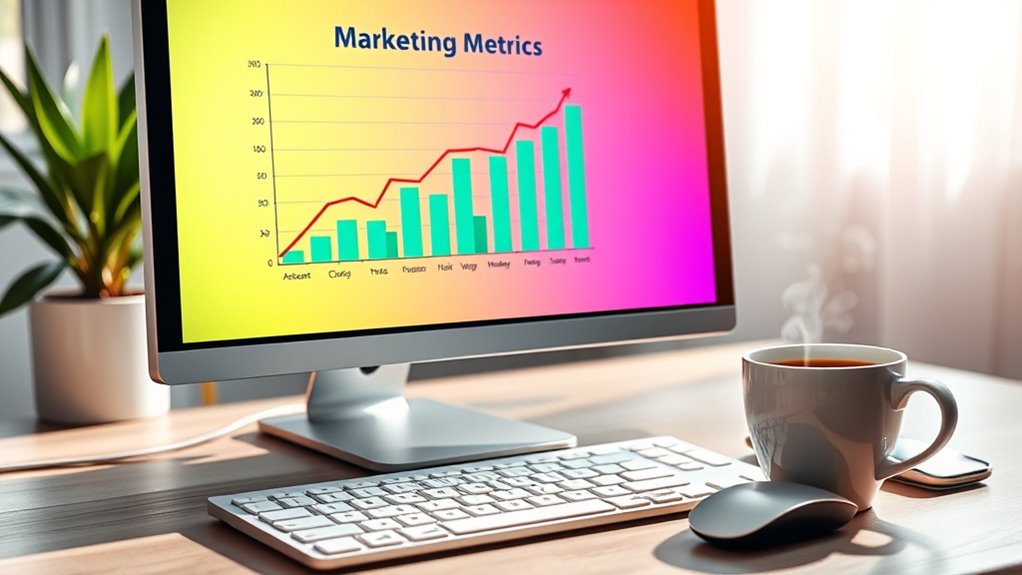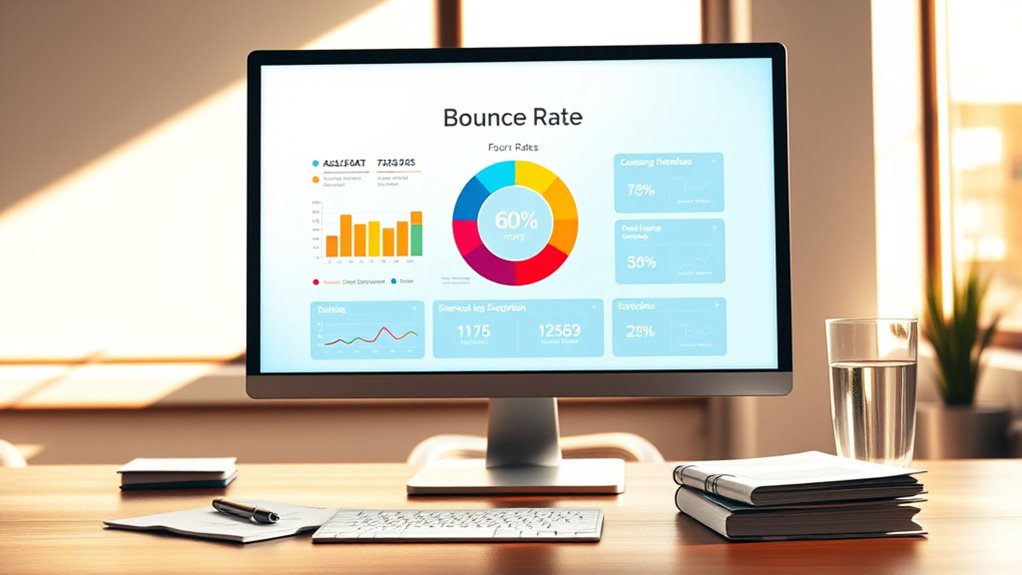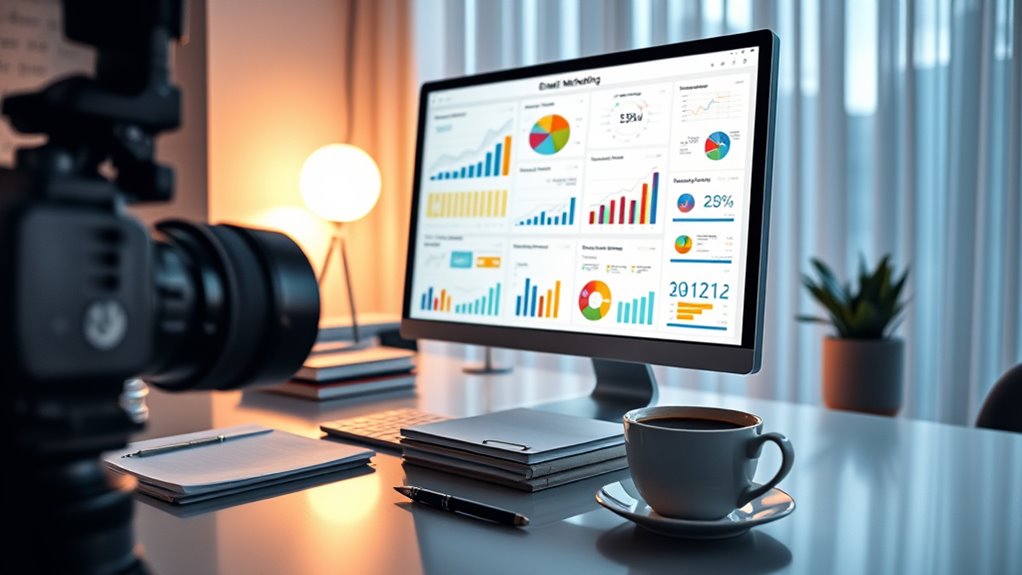Understanding email marketing metrics helps you measure your campaign’s success. Key indicators include open rate, which shows how many recipients viewed your email; click-through rate (CTR), revealing engagement with your links; bounce rate, indicating invalid addresses; and unsubscribe rate, showing content relevance. You also track delivery rate, spam complaints, conversions, read time, and list growth. Mastering these metrics guarantees you optimize strategies effectively. Keep exploring to discover how these insights can elevate your email marketing efforts.
Key Takeaways
- Defines essential email marketing metrics like open rate, CTR, bounce rate, and unsubscribe rate for measuring campaign effectiveness.
- Explains how metrics relate to sender reputation, deliverability, and audience engagement.
- Offers insights into tracking list growth, engagement, and satisfaction indicators to optimize strategies.
- Highlights best practices for improving email performance, including segmentation, personalization, and A/B testing.
- Emphasizes the importance of maintaining healthy practices like list hygiene and managing spam complaints.
Open Rate

Have you ever wondered why some of your emails get opened while others go unnoticed? The answer often lies in effective open rate strategies. Personalization tactics, like addressing recipients by name or tailoring content to their interests, can markedly boost your open rates. Segmentation strategies also play a key role, allowing you to divide your audience into targeted groups based on demographics, behavior, or preferences. When you send relevant, personalized emails, your audience is more likely to recognize their value and open them. Avoid generic messaging that doesn’t speak to their needs. Instead, focus on crafting subject lines and content that resonate with each segment. This focused approach increases engagement, helping your emails stand out in crowded inboxes. Employing email marketing metrics can also help you analyze and optimize your strategies for better results.
Click-Through Rate (CTR)

Your click-through rate (CTR) shows how many recipients engage with your email content. It’s a vital metric because it indicates the effectiveness of your messaging and offers. To boost CTR, focus on compelling calls-to-action and personalized content that resonates with your audience. Incorporating auditory elements can also enhance engagement, especially when combined with visually appealing designs.
Definition and Significance
What exactly does the click-through rate (CTR) reveal about your email campaigns? CTR measures how effectively your email content compels recipients to click on links, indicating engagement levels. A high CTR suggests your message resonates, which often results from targeted email personalization and well-crafted segmentation strategies. When you segment your list, you can tailor content to specific audience segments, increasing relevance and boosting CTR. Conversely, a low CTR signals that your emails may not be engaging or relevant enough, highlighting the need to refine your messaging or segmentation approach. Understanding CTR helps you evaluate the success of your campaigns and guides you in optimizing future efforts. Ultimately, a strong CTR confirms that your emails are compelling enough to prompt action from your audience. Additionally, analyzing how your email content aligns with recipient interests can further enhance engagement and CTR.
How to Improve CTR
Looking to boost your email campaign’s click-through rate? Start by implementing personalization strategies that make your content relevant to each recipient. Use data insights to tailor subject lines, images, and offers, increasing engagement. Don’t forget to conduct A/B testing on your emails—test different headlines, calls-to-action, and layouts to see what resonates best. Analyze the results to optimize future campaigns. Keep your messaging clear, compelling, and targeted, so recipients feel compelled to click. Timing also matters; send your emails when your audience is most active. By combining personalization strategies with systematic A/B testing, you’ll identify what drives more clicks and improve your overall CTR effectively. Remember, continuous testing and refinement are key to sustained success. Additionally, understanding email marketing metrics can help you better interpret your campaign performance and make data-driven decisions.
Bounce Rate

Bounce rate measures how many of your emails don’t reach recipients, and understanding the types of bounces—hard and soft—is key. Hard bounces indicate invalid addresses, while soft bounces show temporary issues like full inboxes. High bounce rates can hurt your sender reputation and lower overall deliverability, so managing them is vital. Additionally, monitoring cookie preferences can provide insights into user engagement and help optimize your email campaigns.
Types of Bounces
Understanding the different types of bounces is essential for managing your email campaigns effectively. Bounces fall into two main categories: hard and soft. Hard bounces indicate invalid email addresses, often due to typos or abandoned accounts, and should be removed promptly through email segmentation. Soft bounces happen when the recipient’s inbox is full or the server is temporarily unavailable. Monitoring bounce types helps you refine your list and apply personalization tactics, ensuring your messages reach engaged users. By analyzing bounce reasons, you can identify issues with your email list quality and prevent future delivery failures. Managing bounce types effectively boosts your sender reputation and improves overall deliverability, making your campaigns more successful and targeted. Additionally, understanding AI vulnerabilities can help you better anticipate and address technical issues affecting email deliverability and security.
Impact on Deliverability
How does your bounce rate directly affect your email deliverability? A high bounce rate signals to email providers that you’re sending to invalid or unresponsive addresses, which can damage your sender reputation. When your sender reputation declines, inbox placement worsens, meaning your emails are more likely to land in spam folders or be blocked altogether. Maintaining a low bounce rate is essential for ensuring your messages reach your subscribers’ inboxes. Regularly cleaning your email list and removing invalid contacts help improve your reputation and boost deliverability. Remember, the more trustworthy your sending practices appear, the better your chances of reaching the inbox consistently. Keeping your bounce rate in check safeguards both your sender reputation and your overall email marketing success. Additionally, understanding textile art techniques can inspire creative ways to enhance your visual content, making your emails more engaging.
Unsubscribe Rate

Have you ever wondered what your unsubscribe rate reveals about your email campaigns? It offers insights into your subscribers’ unsubscribe behavior and helps you understand how well your content resonates. A high unsubscribe rate might indicate that your emails aren’t meeting expectations or are sent too frequently. Conversely, a low rate suggests your audience finds value in your messages. Monitoring opt out statistics allows you to identify patterns and adjust your strategy accordingly. For instance, if certain topics or sending times correlate with increased unsubscribes, you can refine your approach. Remember, some unsubscribe is normal, but consistently high rates signal a need to reassess your content, frequency, or targeting to keep your audience engaged and reduce churn. Additionally, understanding the role of contrast ratio in your visual content can help ensure your emails are visually appealing and easy to read.
Delivery Rate

Delivery rate measures the percentage of your emails that successfully reach your subscribers’ inboxes out of the total sent. A high delivery rate indicates good email segmentation, meaning your messages are targeted effectively and less likely to bounce or be filtered out. Your sender reputation plays a vital role here—if your reputation drops due to spam complaints or poor list hygiene, delivery rates suffer. To improve this metric, focus on maintaining a clean email list, verifying addresses regularly, and ensuring your content aligns with recipient expectations. Proper email segmentation also helps by sending relevant content, reducing the chances of your emails being marked as spam. Additionally, understanding the role of juice cleanses and detox can remind marketers to keep their email practices healthy and beneficial for their reputation. Ultimately, a strong sender reputation combined with strategic segmentation boosts your delivery rate, ensuring your messages land where they’re supposed to.
Spam Complaint Rate

A low spam complaint rate is essential for maintaining your email reputation and ensuring your messages reach subscribers’ inboxes. When recipients mark your emails as spam, it signals to spam filtering systems that your content may be unwanted, risking your deliverability. To keep complaints in check, focus on effective complaint management by sending targeted, relevant content that aligns with subscribers’ interests. Avoid misleading subject lines and ensure easy options for opting out. Regularly monitor your complaint rate, aiming for less than 0.1%, to prevent damaging your sender reputation. A high complaint rate triggers spam filters and can lead to blacklisting, making it harder for your future emails to reach inboxes. Managing complaints carefully helps you build trust and sustain successful email campaigns. Additionally, understanding your Creative Practice Overview can inspire more engaging content that resonates with your audience, reducing the likelihood of complaints.
Conversion Rate

Conversion rate measures the percentage of recipients who take a desired action after opening your email, such as making a purchase, signing up for an event, or downloading a resource. To improve your conversion rate, focus on effective email segmentation; dividing your list guarantees relevant content reaches the right audience. Additionally, A/B testing different elements—like subject lines, call-to-action buttons, or offers—helps identify what resonates best. When you personalize emails through segmentation and optimize messaging via testing, you create more compelling campaigns that drive actions. Keep an eye on your conversion rate regularly to gauge success and refine your strategies. By combining targeted segmentation with continuous A/B testing, you’ll boost your engagement and overall campaign effectiveness.
Read Time

Measuring how long recipients spend reading your emails offers valuable insights into engagement beyond open and click rates. It helps you understand if your content truly resonates. You can improve this metric through A/B testing different subject lines or formats to see what retains attention longer. Personalization strategies also play a essential role—tailoring content to individual preferences can boost read time. Consider these approaches:
- Test various email lengths to find ideal content depth
- Use dynamic content to keep readers engaged
- Segment your audience for targeted, relevant messaging
List Growth Rate

Tracking your list growth rate reveals how effectively your email campaigns attract new subscribers over time. By analyzing this metric, you can identify which strategies, like subscriber segmentation, boost sign-ups. Segmenting your list allows you to target specific audiences with tailored messaging, improving engagement and growth. A/B testing different opt-in offers or sign-up prompts helps determine what resonates best with potential subscribers. Monitoring list growth also uncovers patterns, such as seasonal spikes or declines, enabling you to adjust your tactics accordingly. Consistently increasing your list size is vital for expanding reach and maintaining campaign effectiveness. Focus on refining your segmentation strategies and testing different approaches to optimize your list growth rate continually.
Frequently Asked Questions
How Can I Improve My Email Open Rate Effectively?
To improve your email open rate, focus on subject line optimization by crafting compelling, personalized lines that spark curiosity. Use segmentation strategies to target specific audience groups with relevant content, increasing the likelihood they’ll open your emails. Test different subject lines regularly to see what resonates best. Keep your sender name recognizable and avoid spammy words. These tactics work together to boost your open rates and engage your audience more effectively.
What Factors Influence My Click-Through Rate the Most?
Think of your click-through rate like a garden that needs careful tending. The biggest factors are subject line optimization and segmentation strategies. Craft compelling, relevant subject lines that catch attention and entice clicks. Segment your audience to tailor content specifically to their interests, increasing engagement. When you personalize your emails and optimize your subject lines, you’ll see your click-through rate bloom like a well-cared-for garden.
How Do Bounce Rates Impact Sender Reputation?
Bounce rates directly impact your sender reputation because high bounce rates can trigger email filtering, causing your emails to land in spam folders. Effective bounce management helps you identify and remove invalid addresses, reducing bounce rates. When bounce rates stay low, email filtering systems view you as a credible sender, boosting your reputation. Conversely, ignoring bounce management can harm your sender reputation, making future emails less likely to reach your audience.
What Strategies Reduce Unsubscribe Rates Over Time?
To reduce unsubscribe rates over time, you should focus on list segmentation and content personalization. By segmenting your audience based on interests or behaviors, you send relevant content that resonates with recipients. Personalizing your emails makes subscribers feel valued, increasing engagement and loyalty. Regularly update your list, respect preferences, and test different approaches to optimize your strategy. These tactics help build trust and keep your audience engaged, decreasing unsubscribe rates effectively.
How Is Spam Complaint Rate Determined and Managed?
You determine your spam complaint rate by monitoring how many recipients mark your emails as spam relative to your total sends. To manage this, you keep an eye on spam filters and stay below complaint thresholds set by email providers. Regularly clean your list, personalize content, and avoid spammy language to reduce complaints, ensuring your emails reach your audience and maintain a healthy sender reputation.
Conclusion
Mastering these email marketing metrics is like tuning a finely crafted instrument. When you understand each note — from open rates to bounce rates — you can create a harmonious campaign that resonates with your audience. Keep tracking and optimizing, and your email efforts will hit the right chords every time. Remember, the key is to stay attentive to these metrics—they’re your compass in the ever-evolving landscape of email marketing.
Natali – Editor in Chief (Strategy and Mastery, AI Expert) Natali, our Editor in Chief, is the driving force behind our content’s strategic direction. With a keen eye for detail and a deep understanding of market trends, Natali ensures that our content is top-notch and strategically aligned with our client’s goals. Her expertise in AI helps to seamlessly integrate advanced technology into our marketing strategies, pushing the boundaries of conventional marketing.










